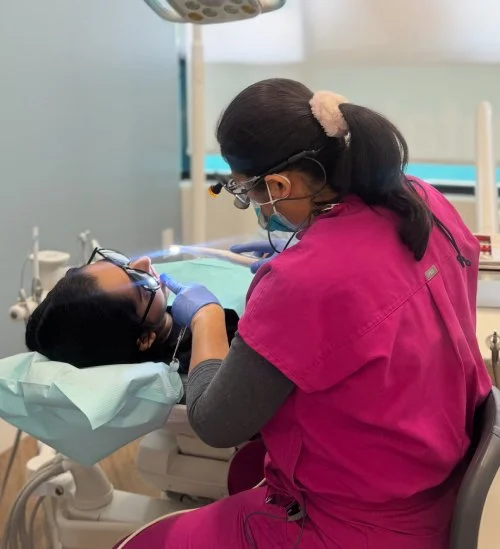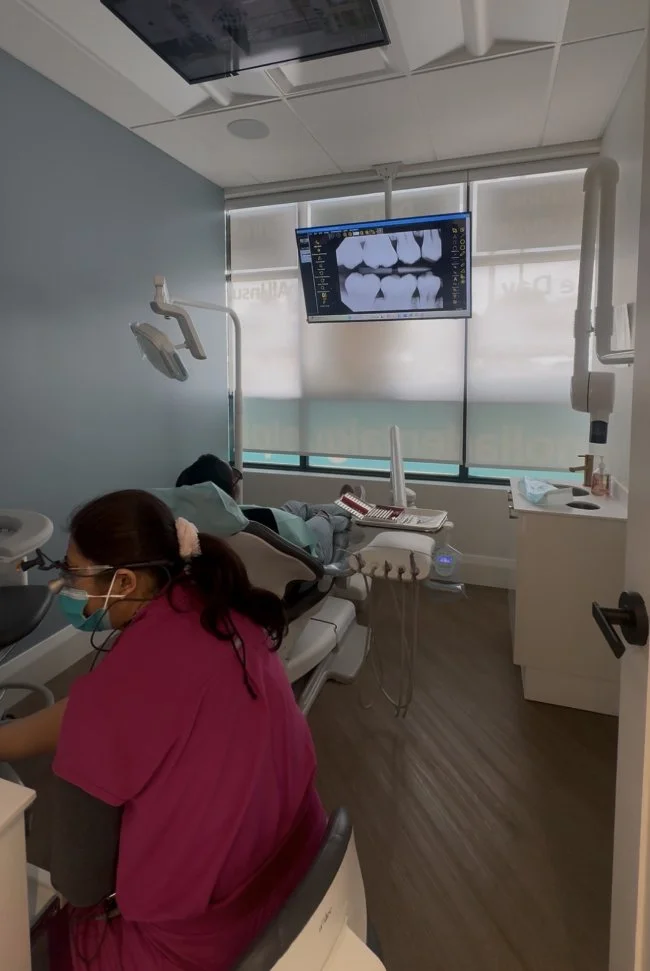 book an appointment
book an appointment
 Call 519-900-5366
Call 519-900-5366

One chip, crack, or gap is all it takes to have you hide your smile. But one visit can change that.
At Magnolia Dental Guelph, our skilled dentists use cosmetic dental bonding to turn minor flaws into radiant smiles. No drilling. No injections. Just skilled artistry with tooth-colored composite resin, shaped to blend in with your natural teeth. The procedure is painless and often completed in under an hour.
If you need a quick fix that is seamless and real, bonding is the ideal solution. It is unobtrusive, inexpensive and effective. Your smile can be rejuvenated in one visit. We are here to make you love it again.
Dental bonding is a cosmetic tooth bonding treatment that utilizes tooth-colored composite resin to enhance the appearance of your teeth. It is a non-invasive procedure, doesn’t involve removal of enamel in the majority of cases, and is done in one visit. It is appropriate for small imperfections such as chips, staining, and minor gaps. The resin is directly applied to the tooth by the dentist, sculpted, and hardened with a curing light. It is an economical and conservative way to enhance smile aesthetics.
Most patients prefer bonding since it seamlessly merges with natural enamel and retains healthy tooth structure. For dental bonding Guelph, come visit our skilled team at Magnolia Dental Guelph.

Dental bonding is an ideal treatment for most typical issues:
This process is frequently incorporated in cosmetic dentistry Guelph for patients who desire refined changes without extensive restorations.

At Magnolia Dental Guelph, we employ high-quality composite material that harmonizes with your natural enamel. It feels like your tooth. It looks like your tooth. And most procedures are completed in one visit.
No drilling. No pain. Just a quick way to repair chips, gaps, or uneven edges with results you can see right away.
Each bonded tooth is hand-crafted to blend with your facial features and brighten your smile naturally. We are careful to notice every curve because subtle elements produce dramatic effects.
If you desire a smile transformation that doesn’t feel forced and looks genuine, dental bonding at our dental clinic Guelph might be just the solution for you.
Dental bonding is an excellent choice for individuals seeking affordable cosmetic dental treatment with minimal recovery and expense. Patients appreciate the way bonding improves the smile without the use of a drill or irreversible changes.
At Magnolia Dental Guelph, we use layering techniques for a realistic finish that blends with surrounding teeth.
The is the step-by-step procedure of tooth bonding process at Magnolia Dental Guelph
We start by choosing a shade of composite resin that will blend with your own tooth color.
The area is lightly etched to enhance bonding. The enamel is prepared with a conditioning liquid.
We fill with the composite resin and carefully shape it to give back the needed shape and contour.
We harden the resin using a blue LED curing light in a matter of seconds.
Once in position, we trim and polish the bonded area to match your tooth.
The entire bonding process takes 30 to 60 minutes for each tooth. Patients usually experience no discomfort and do not require anesthesia. You can resume normal activities instantly. Bonding is a fast, comfortable, and very effective way to repair your smile.
Dental bonding is a safe, non-invasive procedure with minimal risks. The material is strong but not as long-lasting as porcelain. It may stain over time or chip with undue pressure.
The best part is that it can be simply repaired or touched up in one sitting. With proper oral hygiene and routine dental visits, most patients have long-term results. Our dentists at Magnolia Dental Guelph take cosmetic bonding safety precautions at every step.
Good care makes bonding more enduring. Be careful about caring for bonded teeth and avoid habits that can harm the resin.
Inform your dentist if you grind your teeth during sleep, as a night guard will be beneficial. Our staff will instruct you with easy-to-follow dental bonding maintenance instructions to make your results look fantastic.
Here is the breakdown of dental bonding cost Guelph at Magnolia Dental:
At Magnolia Dental Guelph, we make our pricing transparent and affordable. The price ultimately relies on the number of teeth being treated as well as the complexity of the case. If you are not certain of your benefits, our front desk will be happy to assist in reviewing your plan. For honest advice and quality treatment, rely on an affordable dentist in Guelph like Magnolia Dental who prioritizes your needs

Aesthetic precision: Each tooth is individually carved to duplicate your natural smile
Advanced materials: We apply top-quality composites for a realistic outcome
Custom smile design: Your bite, harmony, and shade are precisely coordinated
Patient-centered care: Comfort and beauty are our primary concern
Supportive atmosphere: We listen and walk you through at your own pace
At Magnolia Dental Guelph, cosmetic bonding is as much art as it is science. Natural results, gentle practice, and careful consideration are our priorities at every turn. If you desire subtle enhancement in a warm environment, we are here to help.
Cracked, chipped, or discolored teeth? Magnolia Dental Guelph offers quick, painless, and affordable dental bonding solutions to enhance your smile — all in just one visit.

No, bonding is not permanent but is long-lasting. It can last several years with good maintenance but might require touch-ups or replacement over time, particularly in high-wear areas.
Yes, we very carefully choose a shade that matches perfectly with your enamel. The finish is natural and is virtually unnoticeable from surrounding teeth.
Yes, we can restore numerous teeth in one sitting. This makes bonding a convenient solution for patients with multiple cosmetic enhancements.
No, the treatment is painless and typically does not involve anesthesia. Most patients are comfortable throughout and can resume normal activities immediately after.
Brush and floss daily, do not bite hard objects, and avoid staining foods. Routine dental visits ensure your bonded teeth stay healthy in the long run.
Yes, bonding is frequently employed to close small to moderate-sized gaps. It reshapes the edges of the teeth and corrects alignment without invading the tooth structure.
Bonding is faster and less painful. It leaves more of the natural tooth structure intact and is less expensive, although it will not last as long as porcelain.
In most situations, yes. Insurance can pay for bonding if it’s medically indicated or to repair a broken tooth, but cosmetic-only bonding is not covered.
Yes, bonding is conservative and safe as a treatment for young patients. It can work nicely for filling in chipped teeth or enhancing looks for years of growth.